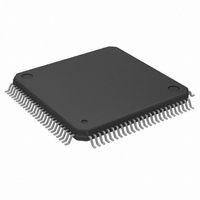M306N4FGTFP Renesas Electronics America, M306N4FGTFP Datasheet - Page 210

M306N4FGTFP
Manufacturer Part Number
M306N4FGTFP
Description
IC M16C MCU FLASH 100QFP
Manufacturer
Renesas Electronics America
Series
M16C™ M16C/6Nr
Datasheets
1.M30622SAFPU5.pdf
(308 pages)
2.M306N4FGGPU3.pdf
(94 pages)
3.M306N4FGGPU3.pdf
(414 pages)
Specifications of M306N4FGTFP
Core Processor
M16C/60
Core Size
16-Bit
Speed
20MHz
Connectivity
CAN, I²C, IEBus, SIO, UART/USART
Peripherals
DMA, WDT
Number Of I /o
85
Program Memory Size
256KB (256K x 8)
Program Memory Type
FLASH
Ram Size
10K x 8
Voltage - Supply (vcc/vdd)
4.2 V ~ 5.5 V
Data Converters
A/D 26x10b; D/A 2x8b
Oscillator Type
Internal
Operating Temperature
-40°C ~ 85°C
Package / Case
100-QFP
Lead Free Status / RoHS Status
Contains lead / RoHS non-compliant
Eeprom Size
-
Available stocks
Company
Part Number
Manufacturer
Quantity
Price
Company:
Part Number:
M306N4FGTFP
Manufacturer:
TI
Quantity:
3 001
Company:
Part Number:
M306N4FGTFP
Manufacturer:
RENESAS
Quantity:
36
Company:
Part Number:
M306N4FGTFP
Manufacturer:
Renesas Electronics America
Quantity:
10 000
Part Number:
M306N4FGTFP
Manufacturer:
RENESAS/瑞萨
Quantity:
20 000
Company:
Part Number:
M306N4FGTFP#UKJ
Manufacturer:
Renesas Electronics America
Quantity:
10 000
Part Number:
M306N4FGTFP#UKJ
Manufacturer:
RENESAS/瑞萨
Quantity:
20 000
- Current page: 210 of 414
- Download datasheet (3Mb)
M16C/6N Group (M16C/6N4)
Rev.2.40
REJ09B0009-0240
Figure 15.33 SIM Interface Connection
Figure 15.34 Parity Error Signal Output Timing
Figure 15.33 shows the SIM Interface Connection. Connect TXD2 and RXD2 and apply pull-up.
15.1.6.1 Parity Error Signal Output
The parity error signal is enabled by setting the U2ERE bit in the U2C1 register to 1 (output enabled).
The parity error signal is output when a parity error is detected while receiving data. This is achieved by
pulling the TXD2 output low with the timing shown in Figure 15.32. If the U2RB register is read while
outputting a parity error signal, the PER bit in the U2RB register is set to 0 (no parity error) and at the
same time the TXD2 output is returned high.
When transmitting, a transmission-finished interrupt request is generated at the falling edge of the transfer
clock pulse that immediately follows the stop bit. Therefore, whether a parity signal has been returned
can be determined by reading the port that shares the UXD2 pin in a transmission-finished interrupt
routine.
Figure 15.34 shows the output timing of the parity error signal
Apr 14, 2006
NOTE:
U2C1 register
This timing diagram applies to the case where the direct format is
implemented.
1: The output of MCU is in the high-impedance state (pulled up externally).
Transfer
RI bit in
RXD2
TXD2
clock
page 186 of 376
"H"
"H"
"H"
"L"
"L"
"L"
1
0
MCU
RXD2
TXD2
ST
D0
D1
D2
D3
(NOTE 1)
D4
SIM card
D5
D6
D7
ST: Start bit
P: Even Parity
SP: Stop bit
P
SP
15. Serial Interface
Related parts for M306N4FGTFP
Image
Part Number
Description
Manufacturer
Datasheet
Request
R

Part Number:
Description:
KIT STARTER FOR M16C/29
Manufacturer:
Renesas Electronics America
Datasheet:

Part Number:
Description:
KIT STARTER FOR R8C/2D
Manufacturer:
Renesas Electronics America
Datasheet:

Part Number:
Description:
R0K33062P STARTER KIT
Manufacturer:
Renesas Electronics America
Datasheet:

Part Number:
Description:
KIT STARTER FOR R8C/23 E8A
Manufacturer:
Renesas Electronics America
Datasheet:

Part Number:
Description:
KIT STARTER FOR R8C/25
Manufacturer:
Renesas Electronics America
Datasheet:

Part Number:
Description:
KIT STARTER H8S2456 SHARPE DSPLY
Manufacturer:
Renesas Electronics America
Datasheet:

Part Number:
Description:
KIT STARTER FOR R8C38C
Manufacturer:
Renesas Electronics America
Datasheet:

Part Number:
Description:
KIT STARTER FOR R8C35C
Manufacturer:
Renesas Electronics America
Datasheet:

Part Number:
Description:
KIT STARTER FOR R8CL3AC+LCD APPS
Manufacturer:
Renesas Electronics America
Datasheet:

Part Number:
Description:
KIT STARTER FOR RX610
Manufacturer:
Renesas Electronics America
Datasheet:

Part Number:
Description:
KIT STARTER FOR R32C/118
Manufacturer:
Renesas Electronics America
Datasheet:

Part Number:
Description:
KIT DEV RSK-R8C/26-29
Manufacturer:
Renesas Electronics America
Datasheet:

Part Number:
Description:
KIT STARTER FOR SH7124
Manufacturer:
Renesas Electronics America
Datasheet:

Part Number:
Description:
KIT STARTER FOR H8SX/1622
Manufacturer:
Renesas Electronics America
Datasheet:

Part Number:
Description:
KIT DEV FOR SH7203
Manufacturer:
Renesas Electronics America
Datasheet:











